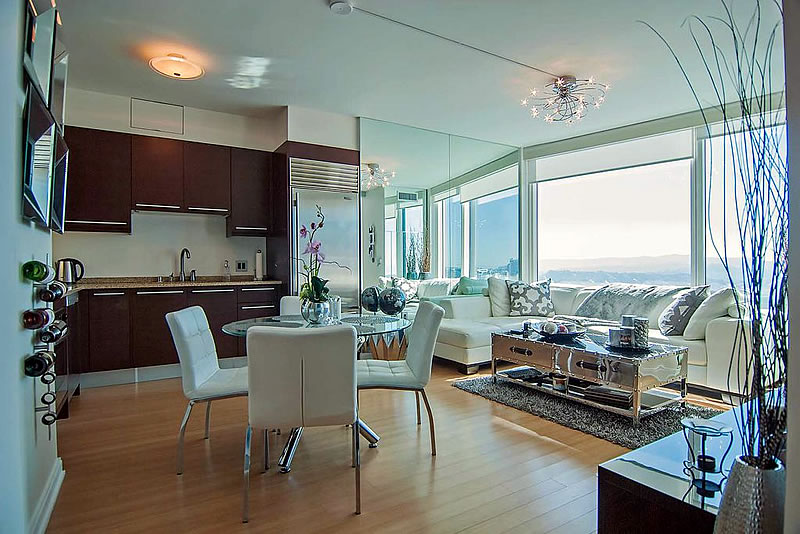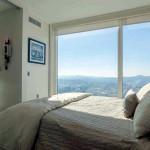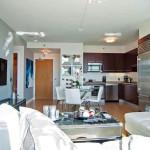As we originally outlined back in the third quarter of 2015:
Purchased for $700,000 in 2012, or roughly $1,150 per square foot, the one-bedroom One Rincon Hill condo #4404 was listed as a rental for $3,800 in mid-2014 and actually rented for $3,750 per month, which included valet parking along with the unobstructed views.
With monthly HOA dues of $724 (circa 2012) and taxes of $9,331 per year, we’ll call it a rough CAP rate, or return on the asset, of 3.9 percent. Of course that’s not accounting for any vacancy or other operating expenses, such as insurance.
With the lease recently renewed for another year without a bump in the rent, which itself is worth noting, the condo is now back on the market for $935,000 and “ready for investors” at $1,545 per square foot. And with the HOA dues having increased to $786.50, the effective CAP rate at asking would be around 2.5 percent.
Withdrawn from the market without a reported sale, 425 1st Street #4404 was listed anew for $998,000 last year and then again for $990,000 this past January, at which point the listed HOA dues had risen to $905 a month and the actual rent for the unit had been removed from the public facing listing.
While technically de-listed prior to closing escrow, the sale of 425 1st Street #4404 has now closed with an $830,000 sale price, roughly 11 percent below its 2015-era pricing and 16 percent below its list price last year.
In terms of the effective CAP rate upon purchase, call it 3.0 percent based on the previous stated rent of $3,750 or a rather familiar sounding 3.8 percent if the actual rent had risen to $4,300 a month, the asking price at which it was advertised last year.
And in terms of apples-to-apples appreciation for the one-bedroom condo with parking on Rincon Hill, call it total appreciation of 18.6 percent since mid-2012 or roughly 3.0 percent per year on a straight-line basis.







This cannot be correct. Case-Shiller is double what it was in 2012, which was basically at the bottom of the recession. 18.6 percent? Really? After realtors fees and transfer taxes, you net 13% over 6 years? And that’s if you buy right at the bottom and sell right near the top.
Not a surprise given the situation for new/newer condos in the SOMA area. There is a reason Crescent is not going ahead with 524 Howard. 3.9% cap rate in the heyday. Meh – nothing to entice the investor in me though others have grabbed at that kind of number given the anticipation a huge appreciation. Those days are gone Any idea of what similar units are renting for in this building? Is $3750 real or wishful thinking?
If you are simply looking at cap rates, then an SF condo won’t look like a good investment. Head on over to Roofstock where you can pick up this beauty in Indianapolis. It’ll probably work out well for you, and a 9.6% cap too! $60K, wave it in!!!
Close to 9% cap rates are available in more dynamic markets than Indianapolis. Not that I have anything against Indianapolis. A good cap rate and a good appreciation rate are what investors (mostly) look for. Right now SF has neither.
Maybe someone bought it to live in instead of to make money? Is that even a thing anymore?
I think this was used as an illustration of what would happen as an investment…not that it necessarily was one. A prudent resident would weigh the costs of renting vs. buy/sell…assuming of course they knew when they were going to leave.
With interest rates rising (maybe another 1.5% according to fed funds guidance) and lots more inventory coming on market in Mission Bay, Soma, Rincon, South Beach, and some stuff sitting for a while from existing new buildings, is now a good time to sell an existing small Rincon Hill Condo? If so, might it be best to wait a while to buy a larger one afterwards?
I see Central Soma Plan bringing lots of jobs, more millennials and soon Get Z coming. I think long term the prices will be higher than they are now in real dollars, but not sure on short term for factors in my first sentence.
One Rincon Hill is in litigation (standard 10 year litigation against builders). It has suppressed the value of every unit in the building. I suspect it was an all cash purchase given only a few banks are willing to underwrite loans on these units until the litigation is resolved.
San Francisco is a boutique market that only makes investment sense if you are gambling on appreciation, which is never a sure thing. Now, at almost any point in the past, if you’d have bet against SF appreciation, you’d have lost that bet — but this property is a clear lesson that not every property in SF is a gold mine, even in a rapidly-rising market. Personally, I think you’d have to be insane to buy a SoMa condo strictly for investment reasons today, especially with thousands of units in the development pipeline still. You could do SO much better elsewhere.
People own in SF because they want to live in SF, or because they want the prestige they may associate with owning in SF, or because they are gamblers, hoping for a big run-up in value. When you can get cap rates of 6-8% in plenty of other places without even looking hard (and even higher if you put some effort into it), SF doesn’t make a lick of sense if your interest is ROI.
Having said all of that, people, myself included, have made huge profits on SF real estate over the years, and will likely continue to do so. But unlike most other markets, investing in SF is one part investing, four parts gambling.
“only makes investment sense if you are gambling on appreciation”
This is a big driver of the cyclical nature of the market.
Many people realize that getting in at the bottom before the up-slope has the double benefit of lower holding costs and the potential for large appreciation. This increases demand, because who wouldn’t want to have free appreciation money showered down upon them?
Loose lending (as in the 2007 era) or low interest rates (as in our current cycle) can let people lever up to higher levels increasing the amplitude of the up cycle. But as you point out, at the top you are left with very high holding costs leading to a poor to negative ROI with little to no appreciation.
“especially with thousands of units in the development pipeline still”
Builders are less sensitive to the future path of prices and will keep building and selling as long as current prices are high. The combination of diminished investment prospects and steady increasing supply eventually cause a down drift of prices.
Once prices start drifting down, you have the prospect of paying high holding costs for the privilege of incurring ever increasing capitol losses. People eventually realize this and this curtails demand, which pushes prices down even further. Until a bottom is hit and the cycle can repeat again.
In a nutshell, the RE cycle is just the result of obvious individual incentives writ large. Huge profits on the up-slope, so demand surges.
“I think you’d have to be insane to buy a SoMa condo strictly for investment reasons today”
Investment insanity at the high flat top, so demand drops off. Investment insanity in spades to buy on the down-slope of a high peak…
I guess the question is will the next bottom be more of a 10% drop or zig zagging for a while or something major like what happened in 2008. I don’t see what impetus there is for the latter to happen. Rate hikes could cause the former. Aren’t there still way more people of high income moving here? Especially international?
I don’t believe there will be a big price drop but rather a zigzag price situation for condos going forward for the short and medium term future. No major price appreciation as has occurred over the past decade. Add in rising interest rates along with SF having the highest construction costs in the country and the slowing population and job growth and voila. Some existing pipeline projects will be abandoned (524 Howard and, apparently, Avant Group’s 1270 Mission St hi-rise) and new project proposals should significantly slow. Not sure if there are “way more” high income people moving here – and that would be relative as net in-migration is slowing – but the factors are not in place to sustain significant condo price appreciation.